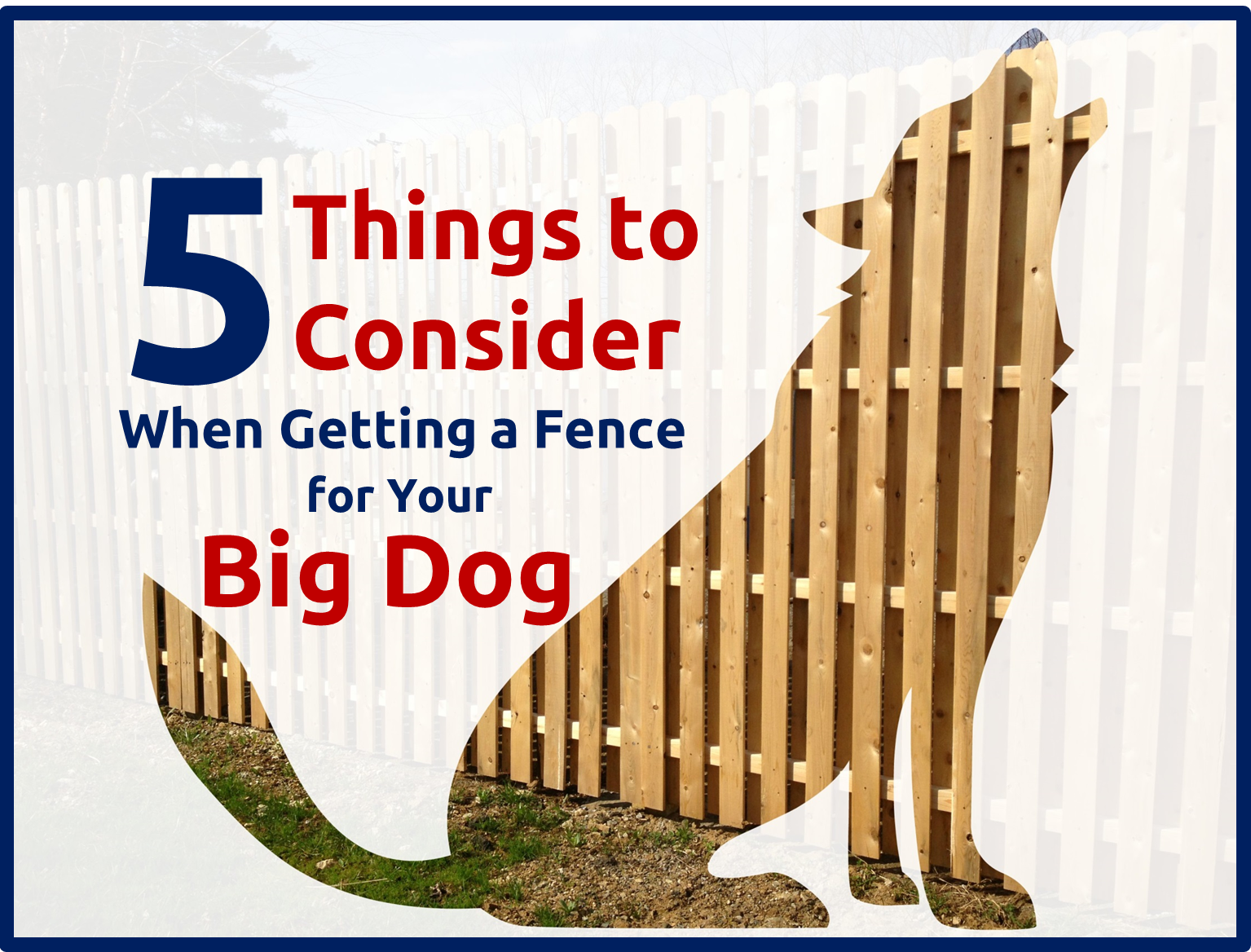
Everyone who has a big dog with tons of energy knows how hard it can be to contain your best friend. After all, many breeds of large dogs want to get in touch with their wild side and chase the neighborhood squirrels or bark at cars. If you have a big, strong, energetic dog, you should think carefully about the type of fence you need before adding it to your yard. The trick is to find a fence that satisfies your budget and aesthetic desires while stopping your furry pal from going on the adventure of his doggy dreams. Here are five factors to keep in mind when choosing the perfect big dog fence!
(Have a small dog? We have a post about fences for small dogs too.)
1. Big dogs need big fences…because they can jump!
A four-foot high fence is unlikely to deter a Husky, Golden Retriever, or Labrador, so you should look for a fence with a height of five or even six feet. For most breeds, six feet should be sufficient. Some owners start adding extensions to make their fences higher and higher. However, if you do this, your dog will learn how to jump a little higher each time! Your best bet, in this case, is to tear down your old fence and install a new six-foot fence rather than making additions. Height isn’t the only factor at play—a big dog is also a strong dog. High-quality wood and vinyl or composite materials can resist charging and chewing better than cheaper, lower end materials.
2. Make that fence impossible to climb
No matter how high your fence is, a clever dog will still try to get over it somehow. Even if he can’t actually jump it, he may be able to climb. When choosing a fence, it’s crucial to make sure the design of the fence itself is totally climb-proof. Chain link fences are a bad idea for climbers—they provide your dog with easy footholds! A solid panel fence, on the other hand, has a flat surface without anywhere for your dog to stick his paws.
Once you have your climb-proof fence, make sure there’s nothing your dog can use to give himself a boost. Don’t place a planter or a birdbath or anything else your dog can climb onto alongside the fence.
Our recommendations for big dog-friendly fences:
Learn More: Protection Fencing for Children, Dogs, and Other Pets
3. Give your dog a little privacy (or, rather, give the squirrels on the other side privacy)
Okay, your dog may not care about privacy at all, but a wooden or vinyl privacy fence is a great option for his (and your) peace of mind. Aside from their climb-proof nature, solid panel privacy fences are great because your dog can’t see what’s on the other side. If he can’t actually see squirrels and other dogs and people and everything else he loves to bark at, he’ll be a lot calmer. He won’t be visible to other dogs on their walks either, who may get distracted and start barking.
Chain link fences drive dogs wild because they can look right through and see exactly what they’re missing! Privacy fences are also much more aesthetically appealing than chain link. Ultimately, choosing the best fence for your large dog depends on how your dog behaves and reacts to the outside world. So take some time to consider what will best suit your four-legged companion before making a decision.
Check out the 10 Reasons Your Dog Needs a Privacy Fence (It’s a list of silly dog gifs!)
4. Think before getting an invisible fence
You may ask, what about invisible fences? Some owners may just want to put up an invisible or electric fence for their big dog and be done with it. If local laws prevent you from installing a high enough fence for your big dog, this may be your only option. However, it is possible that invisible fences worsen behavioral problems in dogs. Think about how you would feel if you got shocked every time you crossed an invisible line!
5. Make your dog not WANT to escape!
Dogs don’t usually like being restricted, whether it’s a physical or invisible barrier. Boredom is a major factor that tempts dogs to try to escape your yard. If your dog requires a lot of exercise but isn’t being walked regularly, putting up an adequate fence will not be an easy fix to your problem. Maybe you’ll be able to prevent your dog from escaping, but your dog won’t be very happy—and an unhappy dog makes an unhappy owner. If you own a large breeding, working, or herding dog, exercise is not likely to be optional—these kinds of dogs simply don’t thrive when they are cooped up in a little yard.
A fence is necessary to keep your dog in your yard, but as a behavioral fix, it’s only a starting point. Creating a dog-friendly yard is one way to keep your dog entertained between the fence walls.
Not everyone has a spacious yard or the ability to provide a large dog with ample exercise. That’s exactly why big dogs aren’t for everyone, but the right fence does go a long way in terms of keeping your dog safe and secure. Managing massive dogs can be a massive challenge, but for owners that are able to take that challenge, it’s worth the effort so you can keep your dog around for massive cuddles.
How do you keep your big dog from getting out of your yard? Have you made any special modifications to your backyard fence? Leave a comment with your experiences and suggestions with other dog owners!
The post 5 Things to Consider When Getting a Fence for Your Big Dog appeared first on The Fence Authority Blog.